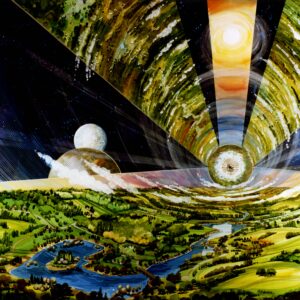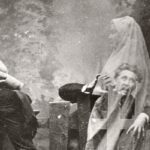A passage from An American Childhood ends with the characteristically brilliant image of a woman diving into water, becoming sealed in her reflection and wearing it “as she climbs rising from the pool, and ever after.” It’s Annie Dillard all over, that passage, that image. And waking up (coming into consciousness), remaining wide awake, leading “a life of concentration” rather than sleep-wading through life, have been her abiding concerns. Her first book, Pilgrim at Tinker Creek, begins with the author waking “in daylight to find my body covered with paw prints in blood.” A writer who never seems tired, who has never plodded her way through a page or sentence, she can only be enjoyed by a wide-awake reader. By which I really mean that she rejuvenates even the word-weary reader who—it can happen to the best of us—has succumbed, like Henry in John Berryman’s fourteenth Dream Song, to being bored by literature “especially great literature.” Maybe that’s part of her appeal: the way that her best work often comes in shapes and forms unencumbered by the protocols associated with great literature. Some of the pieces in Teaching a Stone to Talk may have looked like the kind of interim report “a writer brings out to supplement his real work.” But no, she explains in the Author’s Note, “this is my real work, such as it is.” Genre-resistant non-fiction may be a recognized genre these days but Dillard awoke to its possibilities—and attendant difficulties—back in the early 1970s when she was writing what became Pilgrim at Tinker Creek. “After all,” she noted in a journal, “we’ve had the nonfiction novel—it’s time for the novelized book of nonfiction.” Easier said than done, of course. As she puts it in The Writing Life, “Writing every book, the writer must solve two problems: Can it be done? And, Can I do it?” But it’s the nature of this beast that the answer to the second question only becomes known after the book has been written—or has failed to get written—when there’s no longer any point asking it. It’s very different to geographical exploration and discovery where, once you get to the place to be discovered—there it is, waiting to be claimed and named!—the uncertainty is over. In art the discovery is often gradual—a process of minor discoveries, in fact—riddled with uncertainties and the potential for making that which is discovered vanish before your eyes, like a mirage. “What kind of book is this?” she asked herself of Pilgrim at Tinker Creek, a question that will continue to be asked for as long as the book is read. We read it, in part, to find the answer and, after we have read it—this is the great thing—are still not sure.
In art the discovery is often gradual—a process of minor discoveries, in fact—riddled with uncertainties and the potential for making that which is discovered vanish before your eyes, like a mirage.
So—one question giving rise to another—what kind of writer is Dillard? One of those writers, she decided early on, who chose to defines herself in extra-literary terms: “an explorer of the neighborhood,” “a fugitive and a vagabond, a sojourner seeking signs,” and “a stalker, or the instrument of the hunt itself.” This last idea is especially telling. The Stalker in Tarkovsky’s eponymous film says of a teacher (called Porcupine, as it happens) that “he opened my eyes.” Dillard opens our eyes to the world and to new ways of articulating what we see. More exactly, she alerts us to the possibility of being free of formal conventions that constrain in the guise of enabling. She does this when you first read her and does so again when you re-read her. She did it in Pilgrim at Tinker Creek and she is doing it again in The Abundance in what might be regarded as a re-framing or re-hang of much-loved work. The pleasure and excitement are intense whether you know the original material well or are encountering it—waking to its astonishments—for the first time.
After that fanfare let’s deflate things a bit by introducing a writer who must surely be considered as an antithetical rather than kindred spirit. E. M. Cioran, author of The Trouble with Being Born, claimed to owe everything, torments and insights alike, to his insomnia. While Dillard celebrates the day (“Every day is a god, each day is a god”) Cioran was condemned to wakefulness, to spending his nights wandering in a blaze of unrelieved consciousness. But a strange negative affinity exists between the two. They are, for example—though it is not necessarily the first thing that strikes you about either—wonderfully comic writers. In Cioran the comedy is funereal to the point of absurdity (that’s the point); in Dillard it’s the comedy of rapture. Or at least it’s a comedy that permits prose and thought to soar while inoculating the rapturous against the three ills of which nature writers should live in permanent dread: preciousness, reverence and earnestness (the sure sign, Nietzsche, reminds us, of a slow brain). “The mind wants the world to return its love, or its awareness; the mind wants to know all the world, and all eternity, and God,” she writes in the classic essay “Total Eclipse.” And then continues: “The mind’s sidekick, however, will settle for two eggs over easy.”
On the humour front it helps, also, that Dillard’s pretty much a fruitcake. In an insightful review of Pilgrim at Tinker Creek, Eudora Welty confessed that at certain points “I honestly do not know what she is talking about.” And Pilgrim is far from being Dillard’s most difficult or nuttiest offering; that honour would have to go to Holy the Firm (really bonkers and all the more enjoyable for that). Incomprehension is usually the result of obfuscation—the words refusing to slip into focus—whereas Dillard remains a writer of exceptional clarity, even when we are struggling to grasp the meaning of what is being said so clearly, so brightly.
Perhaps it’s the abundant lucidity that compels her to peer into the darkness of ethical and metaphysical questions. She has returned frequently to the old chestnut of suffering in the world (“Cruelty,” she writes in an insight worthy of Simone Weil, “is a mystery, and waste of pain”) and it is here—to go back a paragraph—that we find more common ground with Cioran. In his despair as a young man Cioran decided that “philosophy is no help at all, and offers absolutely no answers. So I turned to poetry and literature, where I found no answers either, but states of mind analogous to my own.” Dillard’s position on these matters is set out by a character in her novel The Maytrees:
“Having limited philosophy’s objects to certainties, Wittgenstein later realized he broke, in however true a cause, his favourite toy, metaphysics, by forbidding it to enter anywhere interesting. For the balance of Wittgenstein’s life he studied, of all things, religions. Philosophy… had trivialized itself right out of the ball park. Nothing rose to plug the gap, to address what some called ‘ultimate concerns,’ unless you count the arts, the arts that lacked both epistemological methods and accountability, and that drew nutty people, or drove them nuts.”
These “ultimate concerns” are boiled down, on several occasions, to a single nutty question: “to wit, What in the Sam Hill is going on here?” Though she has written two fine novels Dillard’s answers tend not to come in novel form. The novel is generically programmed to describe and map the social landscape. This is neither her main area of thematic interest nor where her talents are uniquely displayed. Early on in An American Childhood young Annie discovered “that I myself was both observer and observable, and so a possible object of my own humming awareness.” Welty, in her review of Pilgrim, was less than wholehearted in her admiration for this canary-in-the-me-mine method: “Annie Dillard is the only person in her book, substantially the only one in her world; I recall no outside human speech coming to break the long soliloquy of the author.” If this, for Welty, was almost the opposite of what it meant to be a writer, it was exactly what attracted Cioran to mystics and saints. Hostile to religion, he nevertheless developed an interest in the mystics because they “lived a more intense life than others. And too, because of their extraordinary pride, me and God, God and me.” It is here, amidst what she calls “the literature of illumination,” that Dillard declares her genius most openly. Actually, let’s put that differently: it’s here that she has made her home. Bear in mind also—the antecedents of Emerson and Thoreau are important—that while the light may be universal it always falls in a particular way on a particular patch of ground. “I never saw a tree,” she declares in a valuable piece of advice to writers of any and every stripe, “that was no tree in particular.” At one point she insists, with the unflappable resolve of a lawyer’s dream witness, on having seen an angel in a field. I’m of the Courbet persuasion but am inclined to believe her, less because she conceived of Pilgrim at Tinker Creek as “what Thoreau called ‘a meteorological journal of the mind’,” than because, after careful deliberation, she confided to her journal that Walden was “really a book about a pond.” In everything she writes she subscribes to the idea—attributed variously to Eluard or Yeats—that “there is another world, but it’s in this world.” Wherever you are in this world, she reminds us, “life is always and necessarily lived in the detail.”
It is here, amidst what she calls “the literature of illumination,” that Dillard declares her genius most openly. Actually, let’s put that differently: it’s here that she has made her home.
Inevitably, then, she has been scrupulous in detailing her whereabouts: where she was from (An American Childhood), where she was living (Pilgrim at Tinker Creek) and where she was going (Stone). That kind of attentiveness means that she also needs to factor in whichever books she had in her duffelbag to sustain and nourish her in these places and phases. And so, at the risk of uprooting her from the native soil of Emerson and Thoreau, I feel similarly at liberty to open up my own bag of books and mention the three British writers who, as the saying goes, beat a path to her door for me.
In Emerson: The Mind on Fire, Robert D. Richardson (Dillard’s husband) enables us to see—almost to share—how Emerson became the writer he did by reading the writers he read. These are the writers that formed him. But what of the path that draws readers to a writer they come to love? That too is formed by writers who not only prepare us for such encounters; they also subtly prepare the writer for us. In turn this writer will prepare the way for other encounters further along the road. For the time being, though, Dillard is where I’m at: a temporary terminus. The three writers who got me to this point have much in common with Dillard, not least a tendency—often regarded as fatal flaw in imaginative writers—to offer advice: one reason, perhaps, why none of them could confine their talents to the novel.
First there is D.H. Lawrence, one of the most insistent and vehement offerers of advice in the English literary canon. But Lawrence’s hieratic tendency—the unwavering belief that he had some kind of cure for the sickness of his times—is always predicated on “his relationship, his bond with everything in creation.” The words are those of his widow, Frieda, who continued to be amazed by this—“no preconceived ideas, just a meeting between him and a creature, a tree, a cloud, anything”—long after his Salvator-Mundi sermonizing had became wearisome. We are in the jurisdiction of the detail so let’s take a tiny example. When Lawrence writes of cypress trees in Twilight in Italy—“as we have candles to light the darkness of night, so the cypresses are candles to keep the darkness aflame in the full sunshine”—he not only makes us see these particular trees in a particular light; he also prepares our eyes for seeing (reading) pages by Dillard which, in turn, bring Lawrence flaring back into life as her–and our–permanent contemporary.
Then there is Rebecca West. The fact that her tone and register are so different—grand where Dillard is scatty—should not distract us from the similarities both incidental and overarching (and therefore tonal, ultimately). By baking a cake for friends, West realizes in Black Lamb and Grey Falcon, “one is striking a low note on a scale that is struck higher up by Beethoven and Mozart.” In The Writing Life Dillard expresses her admiration for a stunt pilot. “It was as if Mozart could move his body through his notes, and you could walk out on the porch, look up, and see him in periwig and breeches, flying around in the sky. You could hear the music as he dove through it; it streamed after him like a contrail.” More generally, there is the shared tendency, the strength of the urge, towards ultimate concerns. Asked to write a book about empire, West declined because she had nothing to say “except for the fancy bits on religion and metaphysics that I would throw in in my demented way.” In her demented way, Dillard is content to throw a lot overboard to make room for the metaphysics. But there is nothing desperate, anorexic or body-denying about her preoccupation with questions of the spirit. In The Abundance‘s concluding essay, the quest for the absolute is represented both by a religious ceremony and by an expedition to the North Pole. Her idea of meta is unashamedly physical. “What’s wrong with golf?” she asks in “How to Live.” “Absolutely nothing.” Well, there’s quite a lot wrong with it, in my view, mainly that it’s not tennis or volleyball. And it is tennis, rather than golf, to which she turns when urging writers to “Hit the edges.” I once heard tennis coach Brad Gilbert give similar instructions to one of his protégés. The phrase he shouted out was “Stretch the court!” but that’s another story. Or maybe it is precisely the story. You can stretch the court by stripping it of a lot of the clutter—the furniture of character—required by the novel but the physicality of story-telling has to remain strong, has to be doubly strong, in fact. In And Our Faces, My Heart, Brief as Photos John Berger, the third point in the British triangle that that enabled me, in an un-Bermuda-like way, to find Dillard—writes that “the traffic between story-telling and metaphysics is continuous.” Here’s a little example of that (foot) traffic from Teaching a Stone to Talk:
“You know what it is to open up a cottage. You barge in with your box of groceries and your duffelbag full of books. You drop them on a counter and rush to the far window to look out. I would say that coming into a cottage is like being born, except we do not come into the world with a box of groceries and a duffelbag full of books—unless you want to take these as metonymic symbols for culture. Opening up a summer cottage is like being born in this way: at the moment you enter, you have all the time you are ever going to have.”
Almost out of time, I can only add that that’s from an essay, “Aces and Eights,” that didn’t make it through the door of The Abundance. There was no room, the guest-list filled up instantly! It’s a reminder of the abundance of material waiting outside, in the rest of her books.
From the foreword to THE ABUNDANCE. Used with permission of Ecco. Copyright © 2016 by Geoff Dyer.
Geoff Dyer
Geoff Dyer’s many books include The Ongoing Moment (winner of the International Center of Photography’s prestigious Infinity Award for Writing/Criticism), But Beautiful (winner of the Somerset Maugham Prize), Out of Sheer Rage (shortlisted for a National Book Critics Circle Award), The Missing of the Somme, the novel Jeff in Venice, Death in Varanasi, and the essay collection Otherwise Known as the Human Condition (winner of a National Book Critics Circle Award). His latest book is White Sands: Experiences from the Outside World. A recipient of a Lannan Literary Fellowship, the E. M. Forster Prize and, most recently, the Windham-Campbell Prize for nonfiction, Dyer is an honorary fellow of Corpus Christi College, Oxford; a fellow of the Royal Society of Literature; and a member of the American Academy of Arts and Sciences. His books have been translated into 24 languages. Dyer is currently writer-in-residence at the University of Southern California.




















